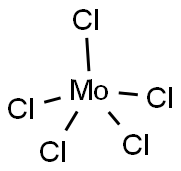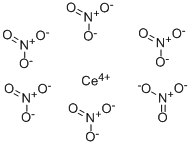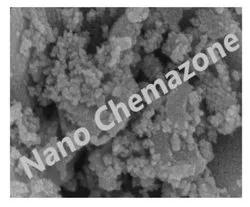MOLYBDENUM(V) CHLORIDE
- CAS NO.:10241-05-1
- Empirical Formula: Cl5Mo
- Molecular Weight: 273.2
- MDL number: MFCD00003467
- EINECS: 233-575-3
- SAFETY DATA SHEET (SDS)
- Update Date: 2025-07-04 15:19:34

What is MOLYBDENUM(V) CHLORIDE?
Chemical properties
Green-black solid, dark red as liquid orvapor.Hygroscopic,reacting with water and air. Soluble in dry ether,dry alcohol, and other organic solvents.
The Uses of MOLYBDENUM(V) CHLORIDE
Chlorination catalyst, vapor-deposited molyb-denum coatings, component of fire-retardant resins,brazing and soldering flux, intermediate fororganometallic compounds, e.g., molybdenum hex-acarbonyl.
The Uses of MOLYBDENUM(V) CHLORIDE
Molybdenum pentachloride (MoCl5) is used as a brazing and soldering flux and to make fire-retardant resins.
The Uses of MOLYBDENUM(V) CHLORIDE
Molybdenum pentachloride MoCl5 is used as a catalyst for several polymerization reactions involving olefins, vinyl monomers, trioxane, ethylene, vinylcyclohexane, cyclopentene, and butadiene.
What are the applications of Application
Molybdenum(V) chloride is obtained from o-dialkoxybenzenes by oxidative trimerization using MoCl5
Definition
ChEBI: Molybdenum pentachloride is a molybdenum halide.
Air & Water Reactions
MOLYBDENUM(V) CHLORIDE may react with water to produce corrosive hydrochloric acid and toxic fumes.
Reactivity Profile
MOLYBDENUM(V) CHLORIDE is a corrosive, hygroscopic solid, on contact with water or steam MOLYBDENUM(V) CHLORIDE decomposes to form hydrochloric acid. When heated to decomposition MOLYBDENUM(V) CHLORIDE emits toxic fumes of molybdenum chlorides and metallic molybdenum [Lewis, 3rd ed., 1993, p. 892]. Explodes on contact with finely divided sodium [Berry D. H., Chem. Eng. News, 1989, 67(47), p. 2]. Reaction with finely divided sodium sulfide is violent, may lead to autoignition [Kaner, R. B., Nature, 1991, 349, p. 510].
Hazard
Irritant.
Health Hazard
TOXIC; inhalation, ingestion or contact (skin, eyes) with vapors, dusts or substance may cause severe injury, burns or death. Contact with molten substance may cause severe burns to skin and eyes. Reaction with water or moist air will release toxic, corrosive or flammable gases. Reaction with water may generate much heat that will increase the concentration of fumes in the air. Fire will produce irritating, corrosive and/or toxic gases. Runoff from fire control or dilution water may be corrosive and/or toxic and cause pollution.
Fire Hazard
Combustible material: may burn but does not ignite readily. Substance will react with water (some violently) releasing flammable, toxic or corrosive gases and runoff. When heated, vapors may form explosive mixtures with air: indoors, outdoors and sewers explosion hazards. Most vapors are heavier than air. They will spread along ground and collect in low or confined areas (sewers, basements, tanks). Vapors may travel to source of ignition and flash back. Contact with metals may evolve flammable hydrogen gas. Containers may explode when heated or if contaminated with water.
Safety Profile
A poison. A corrosive irritant to skin, eyes, and mucous membranes. Reacts with moisture to form hydrochloric acid. When heated to decomposition it emits toxic fumes of Mo and Cl-.
Properties of MOLYBDENUM(V) CHLORIDE
| Melting point: | 194 °C (lit.) |
| Boiling point: | 268 °C (lit.) |
| Density | 2.928 g/mL at 25 °C (lit.) |
| vapor pressure | 1.75 mm Hg ( 25 °C) |
| solubility | Soluble in dry ether, dry alcohol, organic solvents and chlorinated solvents. |
| form | powder |
| color | White to gray |
| Specific Gravity | 2.928 |
| Water Solubility | soluble in dry ether and dry alcohol, in other organic solvents [HAW93] |
| Sensitive | Moisture Sensitive |
| Stability: | Stable, but moisture and air-sensitive. Contact with water liberates toxic gas. Incompatible with water, strong oxidizing agents. |
| CAS DataBase Reference | 10241-05-1(CAS DataBase Reference) |
| EPA Substance Registry System | Molybdenum chloride (MoCl5) (10241-05-1) |
Safety information for MOLYBDENUM(V) CHLORIDE
| Signal word | Danger |
| Pictogram(s) |
 Corrosion Corrosives GHS05  Health Hazard GHS08 |
| GHS Hazard Statements |
H314:Skin corrosion/irritation H351:Carcinogenicity |
| Precautionary Statement Codes |
P201:Obtain special instructions before use. P260:Do not breathe dust/fume/gas/mist/vapours/spray. P280:Wear protective gloves/protective clothing/eye protection/face protection. P301+P330+P331:IF SWALLOWED: Rinse mouth. Do NOT induce vomiting. P303+P361+P353:IF ON SKIN (or hair): Remove/Take off Immediately all contaminated clothing. Rinse SKIN with water/shower. |
Computed Descriptors for MOLYBDENUM(V) CHLORIDE
MOLYBDENUM(V) CHLORIDE manufacturer
Aritech Chemazone Private Limited
New Products
Indole Methyl Resin tert-butyl 9-methoxy-3-azaspiro[5.5]undecane-3-carboxylate Boc-His(Boc)-OH 2-CTC Resin 4-Chloro-7-tosy1-7Hpyrrolo[2,3-d]pyrimidine 5,7-Dibromo-1H-indole 2,5-dichloro-N-hydroxy-4,6-dimethylpyridine-3-carboximidamide 2,2-Dimethoxy-7-azaspiro[3.5]nonane hydrochloride 4-chloromethyl-5-methyl-1,3-dioxol-2-one (DMDO-Cl) R-2-BENZYLOXY PROPIONIC ACID 1,1’-CARBONYLDIIMIDAZOLE 1,1’-CARBONYLDI (1,2-4 TRIAZOLE) N-METHYL INDAZOLE-3-CARBOXYLIC ACID 4-((2-hydroxyethyl)thio)benzoic acid 1-(TERT-BUTOXYCARBONYL)-2-PYRROLIDINONE Methyl 6-methylnicotinate 3-Pyridineacrylic acid tert-Butyl carbazate TETRAHYDRO-2H-PYRAN-3-OL 2-((4-morpholinophenylamino) (methylthio) methylene) malononitrile 3-(4-morpholinophenylamino)-5-amino-1H-pyrazole-4-carbonitrile 2,4-dihydroxybenzaldehyde 1,3-Diethyl-1,3-Diphenylurea Methyl 2-methylquinoline-6-carboxylateRelated products of tetrahydrofuran








You may like
-
 Molybdenum(V) chloride CAS 10241-05-1View Details
Molybdenum(V) chloride CAS 10241-05-1View Details
10241-05-1 -
 Molybdenum(V) chloride CAS 10241-05-1View Details
Molybdenum(V) chloride CAS 10241-05-1View Details
10241-05-1 -
 Molybdenum(V) chloride CAS 10241-05-1View Details
Molybdenum(V) chloride CAS 10241-05-1View Details
10241-05-1 -
 Molybdenum(V) chloride CAS 10241-05-1View Details
Molybdenum(V) chloride CAS 10241-05-1View Details
10241-05-1 -
 Molybdenum(v) chloride 95% CAS 10241-05-1View Details
Molybdenum(v) chloride 95% CAS 10241-05-1View Details
10241-05-1 -
 Molybdenum(V) chloride CAS 10241-05-1View Details
Molybdenum(V) chloride CAS 10241-05-1View Details
10241-05-1 -
 Molybdenum(V) chloride CAS 10241-05-1View Details
Molybdenum(V) chloride CAS 10241-05-1View Details
10241-05-1 -
 Molybdenum Pentachloride (Molybdenum Chloride, MoCl5, 99%), PowderView Details
Molybdenum Pentachloride (Molybdenum Chloride, MoCl5, 99%), PowderView Details
10241-05-1
